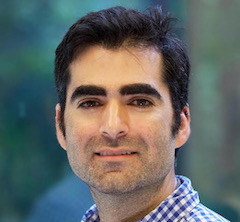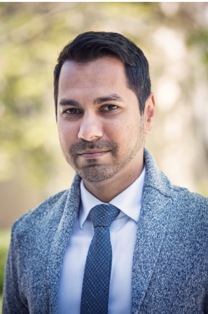In order to supervise a student in the CELL Program, a faculty member must be a member of the Program. The following are current members of the CELL Program who are eligible to supervise students in the Program. If you wish to enroll in the CELL Program and have identified a potential research supervisor whose name does not appear below, please discuss with your prospective research supervisor the possibility of him or her becoming a faculty member of the CELL Program. Information can be found here.
A | B | C | D | E | F | G | H | I | J | K | L | M | N | O | P | Q | R | S | T | U | V | W | X | Y | Z

Molecular mechanisms responsible for cellular pacemaking behaviour and that underlie the function and expression of “pacemaker” channels
Web: http://crg.ubc.ca/accili
Email: eric.accili@ubc.ca
Tel: (604) 822-6900

Differentiation and maintenance of neuronal identity in Drosophila melanogaster, using molecular genetic, biochemical and bioinformatic approaches to examine the roles and intersection of intrinsic transcription factor codes and target-derived signals.
Web: http://www.douglasallanlab.weebly.com
Email: doug.allan@ubc.ca
Tel: (604) 827-5960

The molecular interactions between glia and neurons that occur during development of the nervous system of Drosophila. The development of permeability barriers in polarized epithelia and glia and the formation of the septate and tricellular junctions.
Web: http://www.zoology.ubc.ca/~auld/auldlab/index.html
Email: auld@zoology.ubc.ca
Tel: (604) 822-1977

Molecular mechanisms underlying synapse formation, maintenance and elimination; role of cell adhesion molecules at the synapse.
Web: http://www.bamjilab.com/
Email: shernaz.bamji@ubc.ca
Tel: (604) 822-4746

A major focus of my lab investigates both the cellular and molecular processes that direct trophoblast cell biology in early placental development. Utilizing state of the art cell isolating techniques and three-dimensional culture systems.
Web: https://bcchr.ca/agberistain
Email: aberista@mail.ubc.ca
Tel: 604-875-3573

My research is in evolutionary developmental biology (evo devo) using mainly the crustacean Parhyale, the beetle Tribolium, and the millipede Oxidus, but also sometimes horseshoe crab, tarantula, silverfish, sea spider, and other arthropods. My lab uses molecular, morphological, and embryological approaches to investigate arthropod appendages like legs, wings, and gills as a model to understand the origin and evolution of novel structures, and to elucidate how genetic networks evolve over immense phylogenetic distances of half a billion years.
Web: https://arthropodlegs.com/
Email: heather.bruce@ubc.ca
Tel: 604-827-2678

We aim to understand how the brain forms, stores, and retrieves memories. To do this, we take a multidisciplinary, multiscale approach. We combine big data analysis and cutting-edge experimental techniques to study memory across the spatial scales of the nervous system: molecules, cells, circuits, and behaviour. With this combination, we aim to generate a comprehensive understanding of the neurobiological rules of memory in both health and disorder.
Web: https://www.cembrowskilab.com/
Email: mark.cembrowski@ubc.ca
Tel: (604) 822-3463

Identification of regulatory proteins that control vesicle transport and contribution of defects in protein and lipid trafficking to human disease.
Web: http://cmmt.ubc.ca/research/investigators/conibear/lab
Email: conibear@cmmt.ubc.ca
Tel: (604) 875-3898

Mathematical and computational models of immune cell signalling. Confocal microscopy and single particle tracking for membrane receptors. Population dynamics of HIV virus in vivo.
Web: http://www.math.ubc.ca/~coombs
Email: coombs@math.ubc.ca
Tel: (604) 822-2859

Dong lab studies the molecular biology of the androgen receptor and RNA splicing factors that regulate prostate cancers to develop resistance to anti-cancer therapy. The ultimate goal of our research is to develop novel therapies and improve existing treatments for therapy resistant prostate cancers. We enjoy inspiring young investigators to practice biomedical research, and always welcome ambitious and self-driven young scientists who have strong passion for research to join us.
Transcription and RNA splicing regulation of therapy-resistant prostate cancer progression.
Web: https://www.prostatecentre.com/about-us/people/dr-xuesen-dong
Email: xdong@prostatecentre.com
Tel: (604) 875-4111 ext 63020

Modeling the roles of small GTPases in eukaryotic cell polarization and motility, the actin cytoskeleton, and patterns such as actin waves. Models for microtubule-associated motor protein transport, single-cell wound healing, Rac signaling, and the role of cofilin in mammary carcinoma motility.
Web: http://www.math.ubc.ca/~keshet/keshet.html
Email: keshet@math.ubc.ca
Tel: (604) 822-5889

B cell development, survival, activation and migration.
Web: http://www.microbiology.ubc.ca/research/labs/gold
Email: michael.gold@ubc.ca
Tel: (604) 822-4070

Organization, function, and development of neural circuits that process sensory information in the fruit fly brain.
Web: http://www.zoology.ubc.ca/~gordon/
Email: gordon@zoology.ubc.ca
Tel: (604) 827-4854

Understanding developmental and degenerative pathologies associated with cartilage, bone, and tooth formation: from craniofacial development to osteoarthritis and fracture healing.
Email: daniel.graf@ubc.ca

Mechanisms underlying RNA storage and translational control during oocyte development. Understanding the molecular basis for reproductive aging and meiotic failure.
Web: http://www.greenblattlab.org
Email: ethan.greenblatt@ubc.ca
Tel: (604) 827-0907

Neuronal plasticity during early brain development. Activity-dependent synaptogenesis and dendritic arbor growth with the intent of understanding how brain neurons establish complex morphologies and inter-neuronal connections to create functional brain circuits.
Web: http://www.haaslab.com
Email: kurt.haas@ubc.ca
Tel: (604) 822-9770

Mechanisms of oral and epidermal wound healing.
Web: http://www.dentistry.ubc.ca/research/PeriodontalBiology/hakkinen.asp
Email: lhakkine@dentistry.ubc.ca
Tel: (604) 822-0096

Steroids in growth and development.
Web: http://cps.med.ubc.ca/faculty/hammond/
Email: geoffrey.hammond@ubc.ca
Tel: (604) 822-2498

We seek to develop neuroregenerative and neuroprotective therapies that enable meaningful functional improvements in individuals with spinal cord injury. We use a multidisciplinary research strategy combining cellular, molecular, and bioinformatic approaches together with tissue clearing and 3D imaging analyses in order to identify the processes that prevent damaged axons from regenerating. We are also interested in identifying the cells and circuits that are most important for mediating functional improvements after injury.
Web: https://www.hiltonlab.ca/
Email: bhilton@icord.org

Genetic and epigenetic mechanisms that control the transcriptional networks that drive endocrine pancreas development, function, and proliferation.
Web: http://www.cfri.ca/our_research/researchers/search_researchers/researcher_detail.asp?ID=307
Email: brad.hoffman@ubc.ca
Tel: (604) 875-2000 ext. 4794

Early events in mammalian development and the signalling pathways that regulate these processes.
Web: https://www.bccrc.ca/dept/tfl/people/pamela-hoodless
Email: hoodless@bccrc.ca
Tel: (604) 675-8133

Integrated physiology, from organelle to organism, in the pathogenesis of diabetes, obesity, heart disease, cancer and neurodegeneration.
Web: http://cps.med.ubc.ca/faculty/johnson
Email: james.d.johnson@ubc.ca
Tel: (604) 822-7187
Tim Kieffer Dept. of Cellular & Physiological Sciences, Faculty of Medicine.

The development of novel therapeutic approaches to diabetes using molecular, cellular and physiological techniques.
Web: http://cps.med.ubc.ca/faculty/kieffer
Email: tim.kieffer@ubc.ca
Tel: (604) 822-2156

Identifying the molecular mechanisms underlying cell fate commitment in the pancreas and their relationship to the development of pancreatic cancer.
Web: http://www.janelkopp.com
Email: janelk@mail.ubc.ca
Tel: (604) 827-0626

Combining developmental biology and human genetics to understand how metabolic cells normally develop and how defects in this process leads to disease.
Web: https://pharmsci.ubc.ca/directory/nicole-krentz
Email: nicole.krentz@ubc.ca
Tel: (604) 822-2163

Proteomics, bioinformatics and cell signalling in childhood cancer. Development of proteomics methods and new approaches for better treatment and diagnostics in paediatric malignancies.
Web: http://langelab.med.ubc.ca
Email: philipp.lange@ubc.ca
Tel: (604) 875-2000 ext. 6015

DNA replication, epigenetics and stem cells; Telomeres, genomic instability, aging and cancer; Genetic analysis using single cell Strand-seq.
Web: http://www.terryfoxlab.ca/people-detail/peter-lansdorp
Email: plansdor@bccrc.ca
Tel: (604) 675-8135

Plant molecular genetics and genomics, specifically to understand the natural resistance mechanisms of plants against broad-spectrum of pathogens including fungi, bacteria, and viruses.
Web: http://botany.ubc.ca/people/xin-li
Email: xinli@msl.ubc.ca
Tel: (604) 822-3155

Cellular biology and molecular mechanisms governing integrin-mediated adhesion and motility in childhood cancers.
Web: https://bcchr.ca/jlim
Email: cjlim@mail.ubc.ca
Tel: (604) 875-2000 ext. 4795

Mechanisms underlying interactions between the endoplasmic reticulum and other organelles.
Web: http://cps.med.ubc.ca/faculty/loewen
Email: cloewen@mail.ubc.ca
Tel: (604) 827-5961

The normal physiology of insulin secreting pancreatic beta-cells, as well as the sub-cellular mechanisms that mediate failure and death of the beta-cells in diabetes.
Web: http://www.cfri.ca/our_research/researchers/search_researchers/researcher_detail.asp?ID=428
Email: dluciani@cfri.ca
Tel: (604) 875-2000 ext. 6170

Mechanisms that regulate the formation of islet β-cells from pancreatic stem or progenitor cells. We focus on the gene regulatory networks at play in the progenitor cells and how these networks change during differentiation to mature endocrine cells and in the long-term maintenance of the β-cell.
Web: http://www.betacell.ca
Email: francis.lynn@ubc.ca
Tel: (604) 875-2000 ext. 5426
M

Translational research on retinal diseases and treatment strategies.
Web: http://matsubaralab.med.ubc.ca
Email: jms@mail.ubc.ca
Tel: (604) 875-4383

Receptor assembly and protein trafficking in lymphoid cells. Cell secretion. Signaling by the B cell antigen receptor.
Web: http://www.zoology.ubc.ca/person/matsuchi
Email: matsuchi@mail.ubc.ca
Tel: (604) 822-4881

Microtubule organization during cell division and differentiation and its relationship to childhood and adult cancers.
Web: http://www.bcchr.ca/maxwell-lab
Email: cmaxwell@bcchr.ca
Tel: (604) 875-2000 ext. 4691

The Mizumoto lab is studying various aspects of the neurodevelopment such as synapse pattern formation and neuronal patterning using C. elegans as a model system. We use a combination of classic and advanced genetics, molecular biology and microscopy.
Web: https://www.zoology.ubc.ca/~mizumoto/lab_blog/
Email: mizumoto@zoology.ubc.ca
Tel: (604) 827-0794

The assembly and organization of myofilaments within the body wall muscle of C. elegans. RNA and protein expression profiles in specific tissues and cells, and developmental stages of C. elegans.
Web: http://www.zoology.ubc.ca/~dgmweb
Email: moerman@zoology.ubc.ca
Tel: (604) 822-3365

The investigation of structure-function relationships in cardiac muscle using microscopic and biochemical techniques.
Web: http://crg.ubc.ca/moore
Email: edwin.moore@ubc.ca
Tel: (604) 822-3423

Biochemistry and cell biology of the mechanisms underlying genetically inherited forms of blindness. Mechanisms of protein trafficking within photoreceptor cells, and how these mechanisms relate to these genetic disorders.
Web: http://moritzlab.ophthalmology.ubc.ca/website%20files/Research%20Projects.html
Email: olmoritz@mail.ubc.ca
Tel: (604) 875-4357

Role of dystroglycan, a protein associated with several forms of muscular dystrophy, in the central nervous system. Mechanisms underlying the dystroglycan-mediated targeting and polarized distribution of potassium and water-permeable channels in astrocytes.
Web: http://cps.med.ubc.ca/faculty/moukhles/
Email: hakima.moukhles@ubc.ca
Tel: (604) 822-7882

Tim Murphy is a basic scientist who contributes to understanding of how mouse cortex adapts after stroke, resulting in remapping of brain function from damaged to surviving areas using mouse models. The lab develops new imaging and optogenetic methods that have parallels to human brain imaging and stimulation tools. In developing these tools that laboratory participates in the Canadian Neurophotonics Platform and leads UBC’s Dynamic Brain Circuits in Health and Disease Cluster which actively seeks to articulate new optical methods that are applied to questions related to diseases of the nervous system. Murphy has been a past instructor in the Cold Spring Harbor Laboratory Imaging Neurons and Neural Activity course and UBC’s 3D-microscopy courses. By understanding the stroke recovery process on a circuit level, the lab hopes to advance patient translatable brain stimulation or other plasticity-inducing treatments. More recently the laboratory has extended these approaches to mouse models of psychiatric disorders such as depression and autism. To facilitate circuit interrogation in vivo the lab develops high-throughput models which automate animal imaging.
Web: http://www.neuroscience.ubc.ca/faculty/murphy.html
Email: timothy.murphy@ubc.ca
Tel: (604) 822-0705
N

Cancer cell biology, membrane domains, organelle contact sites, super-resolution microscopy, machine learning, tumor cell migration and metastasis.
Web: http://cps.med.ubc.ca/faculty/nabi
Email: ivan.robert.nabi@ubc.ca
Tel: (604) 822-7000

Gap junctions in neural development and disease.
Web: http://cps.med.ubc.ca/faculty/naus
Email: christian.naus@ubc.ca
Tel: (604) 827-4383
O

Molecular mechanisms of neuronal outgrowth, guidance and directed growth. Remodeling of the cytoskeleton during neurite outgrowth.
Web: http://cps.med.ubc.ca/faculty/oconnor
Email: timothy.oconnor@ubc.ca
Tel: (604) 822-9759
P

Molecular mechanisms of nuclear import of macromolecules and viruses.
Web: http://www.zoology.ubc.ca/~pante
Email: pante@zoology.ubc.ca
Tel: (604) 822-3369

The Plotkin lab’s current developmental biology interests focus on the molecular genetic origins of multicellularity. They investigate the function and evolution of genetic regulatory networks (GRNs) involved in the processes of cell differentiation, wherein they observe and quantify how such GRNs can give rise to differential gene expression and ultimately to different cell fates. To study the genes and mechanisms inducing cell differentiation that are conserved across all multicellular animal species, their model organism is the ctenophore Mnemiopsis leidyi, a candidate for the earliest diverging animal on the phylogenetic tree.
Web: https://plotkinlab.phas.ubc.ca
Email: steve@phas.ubc.ca
Tel: (604) 822-8813

Research in the Pouladi Lab is aimed at understanding how specific genetic factors contribute to the onset of neurological disorders. We develop isogenic human pluripotent stem cells and transgenic animals to model these diseases, with the goal of delineating novel approaches to influence outcomes for neurological disorders. Our current focus includes understanding the etiology of white matter pathology in degenerative disorders such as Huntington’s disease and multiple sclerosis, as well as in developmental disorders like fragile X syndrome and leukodystrophies.
Web: https://www.pouladilab.org/
Email: mahmoud.pouladi@ubc.ca
Tel: (604) 875-3802
R

Reactions of the nervous system to trauma (nerve and spinal cord injuries), with particular emphasis on sensory processing and pain.
Web: http://icord.org/researchers/dr-matt-ramer/
Email: ramer@icord.org
Tel: (604)-675-8821

Behavioural, cellular and molecular mechanisms involved in learning and memory.
Web: http://rankinlab.psych.ubc.ca/
Email: crankin@psych.ubc.ca
Tel: (604) 822-5449

Cellular and synaptic mechanisms of Huntington disease pathophysiology, including changes in striatal NMDA-type glutamate receptor trafficking/function and synaptic plasticity. Combined brain imaging with optogenetic techniques and behavioural testing in animal models of neurological disease.
Web: http://neuroscience.ubc.ca/people/Raymond
Email: lynn.raymond@ubc.ca
Tel: (604) 822-0723

Craniofacial development and evolution.
Web: http://www.dentistry.ubc.ca/faculty-profiles/p-t/joy-richman/research/
Email: richman@mail.ubc.ca
Tel: (604) 822-3568

Genetic, molecular and physiological mechanisms underlying male-female differences in body size, metabolism and stress responses in Drosophila.
Web: http://rideoutlab.weebly.com
Email: elizabeth.rideout@ubc.ca
Tel: (604) 822-0623

Immune Regulation of Developmental programs.
Web: https://rosinlab.dentistry.ubc.ca
Email: jessica.rosin@dentistry.ubc.ca
Tel: (604) 822-0806

Regulation of tissue architecture during breast and ovarian carcinoma progression.
Web: http://cps.med.ubc.ca/faculty/roskelley
Email: calvin.roskelley@ubc.ca
Tel: (604) 822-0779
S

Plant cell biology. Cellular basis of secretion of plant cell wall components.
Web: http://samuelslab.blogspot.ca/
Email: lsamuels@mail.ubc.ca
Tel: (604) 822-3554

Understanding how cell recognizes different sets of environmental cues to specify cell division orientation during embryogenesis. How cell division timings are coordinated during organogenesis of C. elegans intestine.
Web: https://www.zoology.ubc.ca/~sugioka/
Email: sugioka@zoology.ubc.ca
Tel:
T

Integrin function in morphogenesis. Determination of how cells come together to form complex structures and then, once formed, how such structures are maintained.
Web: http://www.tanentzapf-lab.com/site/Home.html
Email: tanentz@mail.ubc.ca
Tel: (604) 827-4334

How changes in transcriptional networks contribute to pathologic changes.
Web: http://cfri.ca/our-research/researchers/results/Details/stefan-taubert
Email: taubert@cmmt.ubc.ca
Tel: (604) 875-3860
U

The retinoid signaling pathway in chondrogenesis and osteogenesis. Mechanisms underlying the commitment and differentiation of skeletal progenitors.
Web: http://cps.med.ubc.ca/faculty/underhill
Email: t.michael.underhill@ubc.ca
Tel: (604) 822-5833
V

Arrangement, function and control of cytoskeletal systems in cells.
Web: http://cps.med.ubc.ca/faculty/vogl
Email: wayne.vogl@ubc.ca
Tel: (604) 822-2395

Growth and development of craniofacial and dental tissues occurs via a sequence of complex cellular interactions that are controlled by a myriad of genetic, epigenetic and molecular events. Our research focuses on different aspects of normal and abnormal craniofacial and dental development; ranging from morphological analysis of growth and asymmetries, molecular events involved in tooth shape and structure, to outcomes-based clinical assessment of surgical outcomes.
Web: https://www.dentistry.ubc.ca/faculty-profiles/u-z/sid-vora
Email: siddharth.vora@ubc.ca
Tel: (604) 827-5575
W

Understanding the pathways and mechanisms by which cells regulate mitochondrial homeostasis during stress.
Web: https://www.weidberglab.com
Email: hilla.weidberg@ubc.ca

Improved detection, diagnosis, and treatment for cancer patients are the overarching research goals of the Williams lab. The Williams lab studies tumor cell fragments called extracellular vesicles (EVs) to identify how they support and promote tumor growth and dissemination. EVs can also be used to detect and report on cancer, and we are using EVs to develop ‘liquid biopsies’ capable of reporting on an individual’s cancer. We also study invasion promoting structures termed invadopodia to understand how cancer spreads and to develop new therapies focused on impairing or stabilizing metastatic disease.
Web: https://pharmsci.ubc.ca/directory/karla-williams
Email: karla.williams@ubc.ca
Tel: (604) 822-9915
Y
Using C. elegans as a model organism, the Yee lab aims to answer unsolved questions in nervous system development. We utilize genetics, -omics, and cell biology approaches to study the molecular mechanisms that control synapse formation and maintenance.
Web: https://www.zoology.ubc.ca/~yeecs/labsite
Email: callista@zoology.ubc.ca

Stem cells in the treatment of ocular surface diseases and age-related macular degeneration.
Web: http://ophthalmology.med.ubc.ca/divisions/cornea-external-disease-refractive-surgery/
Email: sonia.y@gmail.com
